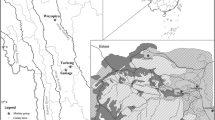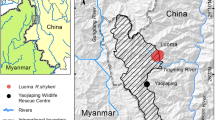Abstract
We investigated patterns of winter feeding tree choice in 4 groups of Sichuan snub-nosed monkeys (Rhinopithecus roxellanae) in Shennongjia Nature Reserve, China. We collected data during 2 winters from 1998 to 2000. The monkeys used mature forest, young forest and shrub forest, but not grassland. Groups used tree species in a significantly nonrandom pattern. There was a similar composition of preferred tree species between different habitats for each group and among the same habitat types for different groups. They preferred Abies fargesii, Pinus armandii and Salix walliciana for foraging. The 3 species occur in varying degrees of abundance in different habitats and were used differently by the 4 groups. The difference is probably due to interhabitat differences in availability of tree species, in addition to microclimate. The mean circumference of a tree had little effect on its preference score, but preferred species tend to be larger. A Wilcoxon signed-rank test indicated that the percentage of trees used and average number of feeding bites per tree is significantly greater for larger trees. For all trees in a given habitat, the percentage of trees used and average number of bites per tree have a significant positive correlation with average tree circumference. Our results indicate that Rhinopithecus roxellanae prefer to feed in large trees more than small trees in a given habitat, thereby preferring mature forest habitat. There is also a group-size effect; larger groups used higher-quality habitats than those of smaller groups. Both tree species and size are the major determinants of feeding choice, but tree species is more important than tree size. Our results have at least three implications for winter habitat conservation of Sichuan snub-nosed monkeys. Conservation efforts should be focused on mature forest because it is better habitat at Rhinopithecus than young forest, as long as the same tree species are present. Secondly, Pinus armandii, Abies fargesii and Salix walliciana should be conserved as top priority in forest communities. Third, the largest trees in each habitat should be given greatest possible protection.
Similar content being viewed by others
REFERENCES
Brown, A.D., and Zunino, G.E. (1990). Dietary variability in Cebus appella in extreme habitats: Evidence for adaptability. Folia Primatologica 54: 187–195.
Chapman, C. (1987). Flexibility in diets of three species of Costa Rican primates. Folia Primatologica 49: 90–105.
Chapman, C. A. (1990). Ecological constraints on group size in three species of Neotropical primates. Folia Primatologica 55: 1–9.
Chapman, C. A., White, F. J., and Wrangham, R. W. (1994). Party size in chimpanzees and bonobos. In McGrew, W. C., de Waal, F. B. M., Wrangham, R. W., and Heltne, P. (eds.), Chimpanzee Cultures, Harvard University Press, Cambridge, MA, pp. 41–57.
Chui, J. S. (1996). Annals of Shennongjia (in Chinese), Hubei Science and Technology Press, Wuhan.
Dietz, J. M., Peres, C. A., and Pinder, L. (1997). Foraging ecology and use of space in wild gold lion tamarins (Leontopithecus rosalia). Am. J. Primatol. 41: 289–305.
Flemming, S. P., Holloway, G. L., Watts, E. J., and Lawrence, P. S. (1999). Characteristics of foraging trees selected by pileated woodpeckers in New Brunswick. J. Wildlife Manag. 63(2): 461–469.
Hladik, C. M. (1975). Ecology, diet and social patterns in Old andNewWorld primates. In Tuttle, R. H. (ed.), Socioecology and Psychology of Primates, Mouton, The Hague, pp. 3–35.
Hu, J. C. (1998). Rhinopithecus roxellanae. In Wang, S. (ed), China Red Data Book of Endangered Animals: Mammalia, Science Press, Beijing, pp. 65–68.
Huo, S. H. (1992). Dendrology (in Chinese), China Forestry Press, Beijing.
Janson, C. H., and Goldsmith, M. L. (1995). Predicting group size in primates: Foraging costs and predation risks. Behav. Ecol. 6: 326–336.
Kirkpatrick, R. C., Gu, H. J., and Zhou, X. P. (1999). A preliminary report on Sichuan snubnosed monkey (Rhinopithecus roxellana) at Baihe Nature Reserve. Folia Primatologica 70: 117–120.
Krebs, C. J. (1999). Ecological Methodology, Addison-Wesley, England.
Li, B. G., Ren, B. P., and Gao, T. F. (1999). A change in the summer home range of Sichuan snub-nosed monkeys in Yuhuangmiao, Qinling Mountains. Folia Primatologica 70: 269–273.
Li, G. H., and Shi, D. C. (1986). Food of golden monkey (in Chinese). Chinese La Animala Mondo 3: 1–3.
Li, Y. M. (2001).The seasonal diet of the Sichuan snub-nosed monkey (Rhinopithecus roxellana) in Shennongjia Nature Reserve, China. Folia Primatologica 72: 40–43.
Liang, B., and Zhang, S. Y. (1998). Hand preference in food researching in Sichuan golden monkeys (Rhinopithecus roxellana). Acta Theriologica Sinica 18(2): 107–111.
Lock, J. M. (1972). Baboon feeding on Euphorbia candelabrum. E. Afr. Wildlife J. 10: 73–76.
Manly, B. F. J., McDonald, L. L., and Thomas, D. L. (1993). Resource Selection by Animals: Statistical Design and Analysis for Field Studies, Chapman and Hall, London.
Marsh, C.W. (1986). A resurvey of Tana primates and their forest habitat. Primate Conserv. 7: 72–81.
Nakagawa, N. (1990). Choice of food patches by Japanese monkey (Macaca fuscata). Am. J. Primatol. 21: 17–29.
Norton, G. W., Rhine, R. J., Wynn, G. W., and Wynn, R. D. (1987). Baboon diet: A five-year study of stability and variability in the plant feeding and habitat of yellow baboons (Papio cynocephalus) of Mikumi National Park, Tanzania. Folia Primatologica 48: 78–120.
Overdorff, D. J. (1996). Ecological correlates to activity and habitat use of two prosimian primates: Eulemur rubriventer and Eulemur fulvus. rufus in Madagascar. Am. J. Primatol. 40: 327–342.
Pearson, S. M. (1993). The spatial extent and relative influence of landscape-level factors on wintering bird populations. Landsc. Ecol. 8(1): 3–18.
Qi, C. J. (1994). Dendrology (in Chinese), China Forestry Press, Beijing.
Remis, M. J. (1997). Western lowland gorillas (Gorilla gorilla gorrilla) as seasonal frugivores: Use of variable resources. Am. J. Primatol. 43: 87–109.
SAS Inc. (1993). User's guide, SAS Institute.
Shi, D. C., Li, G. H., and Hu, T. Q. (1982). Preliminary studies on the ecology of golden-haired monkey (in Chinese). Chin. Zool. Res. 3(2): 105–110.
Stanford, C. B. (1991). Behavioral ecology of the capped langur in Bangladesh: Reproductive tactics in one-male groups. Contributions to Primatology, Vol. 26, Karger, Basel.
Stanford, C. B. (1998). Chimpanzee and Red Colobus: The Ecology of Predator and Prey, Harvard University Press, Cambridge, MA.
Steel, D., and Torris, W. (1960). Principles and Procedures of Statistics With References of Biological Sciences, McGraw-Hill, New York.
Stevenson, P. R., Quinones, M. J., and Athumada, J. A. (1994). Ecological strategies of woolly monkeys (Lagothrix lagotricha) at Tinigua National Park, Colombia. Am. J. Primatol. 32: 123–140.
Strier, K. B. (1991). Diet in one group of woolly spider monkeys, or muriquis (Brachteles arachnoides arachnoides). Am. J. Primatol. 23: 113–126.
Terborgh, J., and Janson, C. H., (1986). The socioecology of primate group. Ann. Rev. Ecol. System. 17: 111–135.
Watts, D. P. (1991). Strategies of habitat use by mountain gorillas. Folia Primatologica 56: 1–16.
Wiens, J. A. (1989). The Ecology of Bird Communities, Vol. 2: Processes and Variations, Cambridge University Press, Cambridge, England.
Williams, C. S., and Marshall, W. H. (1938). Duck nesting studies, Bear River Bird Refuge, Utah, 1937. J. Wildlife Manag. 2: 29–48.
Wrangham, R. W. (1980). An ecological model of female-bonded primate groups. Behaviour 75: 262–292.
Wuhan Institute of Botany. (1980). Shennongjia Plants (in Chinese), Hubei People Press, Hubei.
Zhang, S. Y., Ren, B. P., and Li, B. G. (1999). A juvenile Sichuan gold monkey (Rhinopithecus roxellanae) predated by a goshawk (Accipiter gentilis) in the Qinling Mountains. Folia Primatologica 70: 175–178.
Zhu, Z. Q. (1992). Status and conservation of snub-nosed monkey at Shennongjia Nature Reserve (in Chinese). Chin. Wildlife 67: 16–17.
Zwicker, S. M., and Walters, J. R. (1999). Selection of pine for foraging by red-cockaded woodpeckers. J. Wildlife Manag. 63: 843–852.
Author information
Authors and Affiliations
Rights and permissions
About this article
Cite this article
Yiming, L., Stanford, C.B. & Yuhui, Y. Winter Feeding Tree Choice in Sichuan Snub-Nosed Monkeys (Rhinopithecus roxellanae) in Shennongjia Nature Reserve, China. International Journal of Primatology 23, 657–675 (2002). https://doi.org/10.1023/A:1014981919762
Issue Date:
DOI: https://doi.org/10.1023/A:1014981919762




